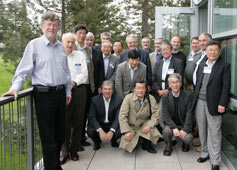
Handy Links
SLAC News Center
SLAC Today
- Subscribe
- Archives: Feb 2006-May 20, 2011
- Archives: May 23, 2011 and later
- Submit Feedback or Story Ideas
- About SLAC Today
SLAC News
Lab News
- Interactions
- Lightsources.org
- ILC NewsLine
- Int'l Science Grid This Week
- Fermilab Today
- Berkeley Lab News
- @brookhaven TODAY
- DOE Pulse
- CERN Courier
- DESY inForm
- US / LHC
SLAC Links
- Emergency
- Safety
- Policy Repository
- Site Entry Form

- Site Maps
- M & O Review
- Computing Status & Calendar
- SLAC Colloquium
- SLACspeak
- SLACspace
- SLAC Logo
- Café Menu
- Flea Market
- Web E-mail
- Marguerite Shuttle
- Discount Commuter Passes
-
Award Reporting Form
- SPIRES
- SciDoc
- Activity Groups
- Library
Stanford
Around the Bay
ICFA Sharpens Focus on the Energy Frontier
"Particle physics is at a crossroads," said Chairperson Albrecht Wagner of the International Committee for Future Accelerators, in the opening moments of the ninth ICFA Seminar last Tuesday in Kavli Auditorium. "The Standard Model stands triumphant," Wagner said, "yet incomplete."
Evidence from past and present particle accelerators supports the Standard Model of the fundamental particles that make up matter, to a breathtaking precision, many physicists say. But observations from cosmology make a convincing case for additional matter—in large quantities—not accounted for. The Standard Model, it seems, provides pieces that fit elegantly, but do not complete, the particle physics puzzle. The next discoveries, Wagner said, will require experiments at energies beyond those of previous accelerators, into the extremely high energies present moments after the Big Bang. To reach this TeV energy scale, he said, physicists worldwide must concentrate their efforts at very few, very large accelerators.
Those large, international accelerators were a central subject at this year's ICFA Seminar, which took place at SLAC from October 28 to 31. ICFA hosts the seminar every three years to bring together strategic decision makers and leading scientists from governments, funding agencies, laboratories and universities around the globe to discuss progress and future plans in high-energy physics.
ICFA was established in 1976 by the International Union of Pure and Applied Physics to facilitate international collaboration in the creation and use of particle accelerators. Today, its members represent scientific organizations from the U.S., Canada, the CERN member states, Russia, China, Japan and other interested nations, as well as the IUPAP Commission on Particles and Fields.
Last week's seminar highlighted the likelihood of reaching the TeV energy frontier soon, with the hope of first collisions in the Large Hadron Collider as soon as spring 2009. "With the LHC," Wagner said, "the first major step will have been taken to look beyond the Standard Model." The seminar's second session focused on status and prospects for the LHC and its key experiments. Later sessions addressed concepts and technical designs for future colliders, including the proposed International Linear Collider, an electron–positron smasher to complement data from the LHC's proton collisions.
Discussions during the 4-day seminar also included potential next steps beyond the SLAC and KEK B Factories, including SuperB in Europe, SuperKEKB in Japan, BEPC II in China, as well as a tau/charm quark factory in Russia. Roundtable discussions focused on "Maintaining Vibrant Accelerator Laboratories across the Globe." Other sessions addressed accelerator research, design, and applications from light sources to medical instrumentation. Participants discussed plans and status of experiments in neutrino physics, particle astrophysics and more that are needed to begin filling in puzzle pieces beyond the Standard Model.
Those next pieces depend on data from a broad program of complementary, accelerator-based and non-accelerator-based experiments, according to Hitoshi Murayama, founding director of the Institute for the Physics and Mathematics of the Universe at the University of Tokyo. In his opening address, Hitoshi Murayama pointed to observations of cosmic rays, atmospheric neutrinos, radioactivity and dark matter that have helped shape theory about physics beyond the Standard Model. These experiments need effective follow-up with accelerator-based experiments, he said, to test how physics really behaves in the TeV scale.
The accelerator experiments call for a factor of 1000 improvement in five different key areas of accelerator performance, discussed by Atsuto Suzuki, Director General of KEK and incoming Chair of ICFA, on the final day of the seminar. In his closing talk, Suzuki laid out a challenge of achieving those improvements. Worldwide collaboration across fields of particle science was the focus of the seminar's final talk by DESY physicist Rolf Heuer, soon to be director general of CERN. Heuer argued the case for global development of a coherent program in particle physics and particle astrophysics, riding on the anticipated successful first collisions of the LHC and prospects for new physics discoveries at the energy frontier, neutrino physics, and in particle astrophysics in the next few years.
"I believe the ICFA Seminar summarized well the case for exciting present and future outstanding science opportunities at the energy frontier, intensity frontier and cosmology frontier, and the strong interplay between these different approaches," said conference organizer and SLAC physicist David MacFarlane. "It also laid the foundation for possible future directions of the field, based on anticipated discoveries at the LHC and elsewhere."
—Shawne Workman
SLAC Today, November 3, 2008
